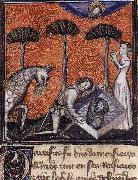El Petróleo al por mayor de China que no Pinta Mínimo
|
|
|
|
|
|
|
|
|
|
29,5 x 22,5 cm (whole page) Bodleian Library, Oxford The illumination depicts Narcissus and Echo. The most extensively illuminated and popular vernacular poem of the period was the Roman de la Rose, begun by Guillaume de Lorris (d. c. 1235) and finished by Jean de Meung (c. 1240-c. 1305). Here the garden of love becomes a setting for a complex allegory of the sexual act in which love's pleasures become equivocal for the yearning lover. Both poets were influenced by optical theories of the time and there is a long digression on the function and meaning of mirrors. The mirror had traditionally been an emblem of the vanity or "luxuria", but it is "oiseuse" or idleness, who looks into her mirror in this work. Early in the poem the association between mirroring the self and love is evoked in a description of Narcissus and Echo, subtly illuminated by a Parisian artist. In the miniature we see Echo, whose love for Narcissus was not answered, asking God that the hard-hearted Narcissus might one day be tormented and burned by love himself. Returning from hunting and leaving his horse, the young man bends down by a pool to drink and there he "saw his face and nose and mouth, clear and sharp". Falling in love with his own reflection, he pines away and dies of love. The artist has attempted to represent the reverse mirror reflection of the square pool, creating a symmetry suggestive of the closed circuit of his desire. But the point of the narrative is not that Narcissus has fallen in love with himself, in the modern sense of narcissism, but that he has been so captivated by an image that he forgets everything else. His sin is really idolatry, not self-love, indicative of the way in which, even by this time, the mirror was associated less with the notion of the self and more with the creation of an alternative, illusory, reality. , MINIATURIST, French , Roman de la Rose , 1351-1400 , French , illumination , mythological |
|
|
|
|
CONTACTE EEUU
China de Xiamen el Petróleo al por mayor que Pinta la Barra de Soga Marco al por mayor que Moldea el Espejo Pinturas Estiradas Encuadradas |
|








